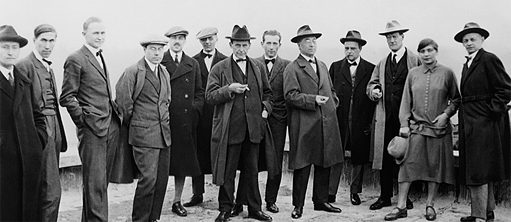Media arts – Dance experiments – Urban design | Celebrating the centenary of the Bauhaus in 2019 | #bauhaus100
About Bauhaus
100 years ago, in summer 1919, the story of the probably most famous German art academy began with the founding of the Bauhaus in Weimar. During its almost fourteen years of existence, the Bauhaus revolutionised creative and artistic thinking, architecture, painting and design worldwide. The distinguished teachers who worked here included Walter Gropius, Ludwig Mies van der Rohe, Paul Klee, Wassily Kandinsky and Oskar Schlemmer.
Founded in Weimar, relocated to the up-coming industrial city of Dessau in 1925 and finally re-founded in exile in the USA and Israel after a short period in Berlin, the Bauhaus documents a piece of German history. It brought together a younger generation of students and teachers who rejected the nationalistic, militaristic, and authoritarian past and insisted on the social relevance of the arts in an emerging democratic society.
What started as a German phenomenon quickly became a meeting point for the international avant-garde which allowed both male and female students to practice art in an up to then unknown extend of freedom. Their radical imagination for new practices, new forms of learning, and new lifestyles spawned revolutionary ideas – which take effect until today. According to the Bauhaus teachings, the individual and the material environment should be freed from all that was unnecessary. And also the relationship between the arts, craft, design, and the building should be rethought.
Bauhaus and film
One example of a concept developed by the Bauhaus is the film in visual art. The Bauhaus professor László Moholy-Nagy already said: "One can no longer jealously separate painting, photography, film and the light play." The film and the theatre were considered as ideal medium for combining various visual arts. Thus, the Bauhaus was far ahead of its time: today, the screening places of moving images are more diverse than ever before. Films are not only projected in the cinema, but also in galleries, theatres, museums, pubs, the Internet and on mobile devices.
Until today, the opinion that there exist no "Bauhaus films" is widely spread, even though there is a respectable film practice of teachers and students of the Bauhaus. These will be presented in the video installation of the Goethe-Institut Indonesia EDITION BAUHAUS. It documents how the Bauhaus interpreted the age of technology and machine. Its representatives used the film as a strategy to actively shape the technical world of perception of the present. In the following original film- and light projections by the Bauhaus artists Ludwig Hirschfeld-Mack, Wassily Kandisky, Kurt Schmidt, Lother Schreyer and Oskar Schlemmer are presented.
Back
